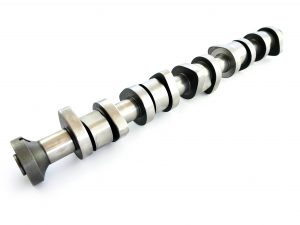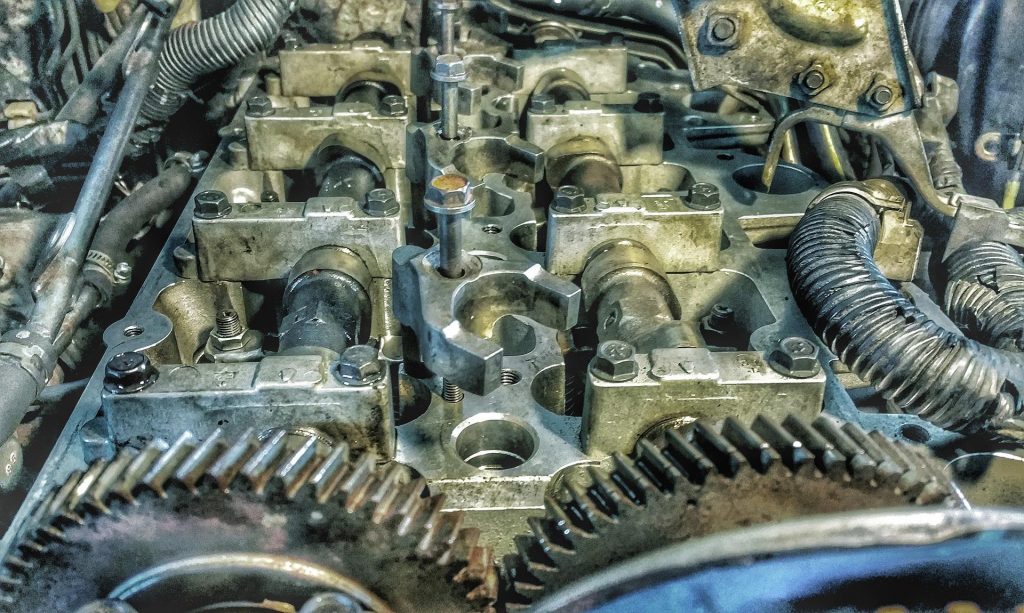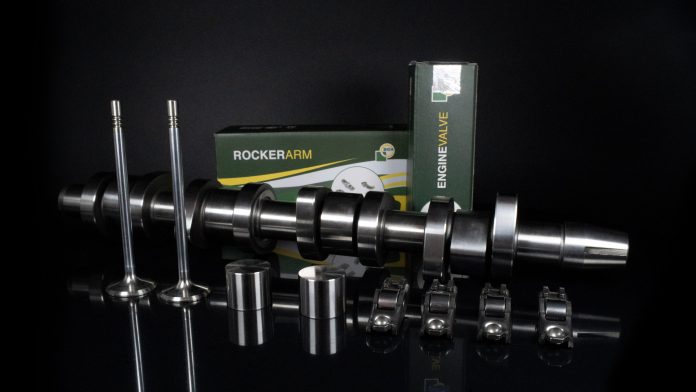Camshafts are a part of the top half (cylinder head) of the engine which converts the bottom half (crankshaft) of the engines rotational motion into reciprocation (linear) motion making the intake and the exhaust valves open and close in a coordinated fashion to control the engine’s combustion cycle.
Common symptoms of a failing camshaft
- Loud Noises from the engine: when the camshafts’ lobes are worn out you will hear a loud tapping and ticking noise coming from the upper part of your engine. As camshaft lobes wear the valves’ clearance will increase making them noisier.
- Cylinder Misfire: damaged camshafts are likely to cause cylinder misfires because the valves which are controlled by the defective lobes won’t open and close in time. This will prevent the air-fuel mixture in the combustion chamber from igniting properly which will lead to poor ignition. The engine will eventually lose power and run rough increasing fuel consumption. Smoke, fumes, and popping sounds are also more likely to come out from the tailpipe.
- Metal Debris in the Engine Oil: as the camshaft lobes wear out, metal debris will contaminate the engine oil. You probably don’t get to see the metal when you check your engine’s oil level, but it will come out when the oil is drained through the sump pan plug.
- Visible Signs of Damage: some valve covers have inspection plugs that allow you to take a glimpse of what’s happening underneath. Some camshafts are partially visible when the oil cap is removed. If you don’t find any visible signs of damage or your valve cover does not have any inspection plugs, and if the camshaft/s are not visible through the valve cover oil filler – you will have to remove the valve cover to be able to inspect.
- When you have your camshafts exposed, check for scored camshaft journals, worn-out camshaft lobes, or any other signs of scratches and damage to determine what condition the camshaft and related components are in.
- Engine Backfiring: worn-out camshaft lobes can cause your engine to backfire. This happens when fuel vapours ignite outside the combustion chamber (for example, in the intake manifold or the exhaust system) due to the valves failing to open or close in time to keep the air-fuel mixture inside the cylinder as it explodes.
- Check Engine Light On: engine misfire, backfires, and any other timing issues will generally save an error code in your vehicle’s ECU (Engine Control Unit) as a memory fault which leads to check engine light being turned on in your instrument cluster.

Camshaft failure causes
Camshafts should last the engine’s lifespan; however, there are several factors which can lead to premature camshaft failure – poor lubrication caused by bad or contaminated oil, lack of oil due to a faulty oil pump or blocked oil passages. On rare occasions automakers may release engines with camshafts made from defective or weak materials – which will prematurely wear out and will need to be replaced. There have been some cases of engine recalls because of defective camshafts by various automakers.
- Camshafts need to be re-fitted properly, this includes lubricating the camshaft’s lobes and the bottom of the lifter’s face on flat tappet cams. Some cams need just regular engine oil before being mounted to ensure proper lubrication during the first engine start-up; however other types may need a special lubricant to be applied as they are being mounted. This also applies for new cams when they are being replaced. It is important to follow the manufacturers fitting instructions when installing new camshafts and related components to avoid premature wear and other issues which may lead to camshaft failure.
- Depending on the type, new camshafts may need a break-in process – an improper break-in may cause premature camshaft wear. Always follow the manufacturer’s instructions carefully when installing a new camshaft.
- Everything must be clean before installing the new cams – checking the oil passageways, drillings, and ducts are clear and free of any pollutant particles will ensure that no premature failure will occur.
- In some extreme cases (valve crashes or cylinder head failures) camshafts can crack or break due to a hard collision with a connecting rod or other cylinder’s head components.

Blown Head Gaskets
- When coolant mixes with oil due to a blown head gasket the contaminated oil will fail to lubricate the engine’s moving parts properly. This may result in camshaft and valve train damage due to excessive friction between the cylinder head moving parts.
- Broken Dowel Pins: some engines have camshafts with dowel pins. These pins don’t drive the camshaft or hold it in place but are used to mark the right position where the timing pulley or sprocket should be. Timing pulleys or sprockets are held against the camshaft by bolts. If these bolts are loose or torqued out of specs they could stretch and allow the pulley to rotate resulting in an out of tune engine and a damaged camshaft.
When is it time to change the camshaft?
Camshafts should last the lifespan of the engine – at least 186,000 – 248,000 miles. Failing camshafts can lead to extensive and expensive engine damage which is why they need to be replaced immediately after failure symptoms have been identified.
About BGA (BG Automotive):
BGA is an Automotive Aftermarket parts supplier, celebrating over 90 years of OE manufacturing heritage as the aftermarket division of the largest privately owned OE supplier, 4BG Group, established in 1929.
BGA focuses on providing one of the largest ranges of high quality, competitively priced parts in the aftermarket containing Auxiliary Drive, Camtrain, Cooling, Gaskets, Lubrication, Power Steering, Steering & Suspension, Timing Belt Kits, Timing Chain Kits and Transmission.



